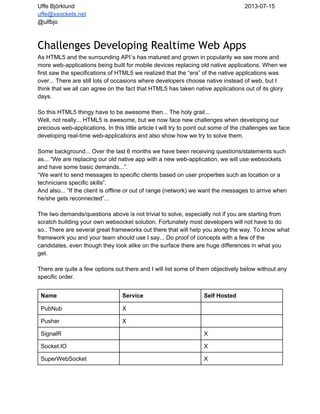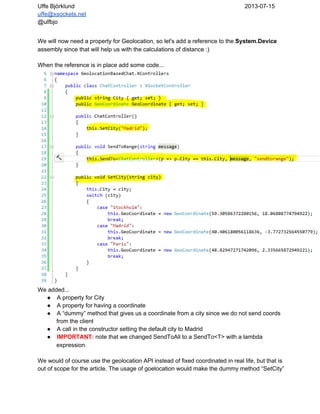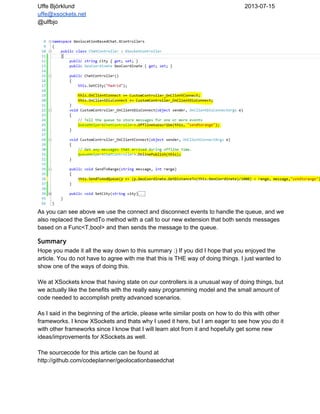Challenges Developing Realtime Web Apps
- 1. Uffe¬†Bj√∂rklund 2013¬≠07¬≠15 uffe@xsockets.net @ulfbjo Challenges Developing Realtime Web Apps As¬†HTML5¬†and¬†the¬†surrounding¬†API¬īs¬†has¬†matured¬†and¬†grown¬†in¬†popularity¬†we¬†see¬†more¬†and more¬†web¬≠applications¬†being¬†built¬†for¬†mobile¬†devices¬†replacing¬†old¬†native¬†applications.¬†When¬†we first¬†saw¬†the¬†specifications¬†of¬†HTML5¬†we¬†realized¬†that¬†the¬†‚Äúera‚Ä̬†of¬†the¬†native¬†applications¬†was over...¬†There¬†are¬†still¬†lots¬†of¬†occasions¬†where¬†developers¬†choose¬†native¬†instead¬†of¬†web,¬†but¬†I think¬†that¬†we¬†all¬†can¬†agree¬†on¬†the¬†fact¬†that¬†HTML5¬†has¬†taken¬†native¬†applications¬†out¬†of¬†its¬†glory days. So¬†this¬†HTML5¬†thingy¬†have¬†to¬†be¬†awesome¬†then...¬†The¬†holy¬†grail... Well,¬†not¬†really...¬†HTML5¬†is¬†awesome,¬†but¬†we¬†now¬†face¬†new¬†challenges¬†when¬†developing¬†our precious¬†web¬≠applications.¬†In¬†this¬†little¬†article¬†I¬†will¬†try¬†to¬†point¬†out¬†some¬†of¬†the¬†challenges¬†we¬†face developing¬†real¬≠time¬†web¬≠applications¬†and¬†also¬†show¬†how¬†we¬†try¬†to¬†solve¬†them. Some¬†background...¬†Over¬†the¬†last¬†6¬†months¬†we¬†have¬†been¬†receiving¬†questions/statements¬†such as...¬†‚ÄúWe¬†are¬†replacing¬†our¬†old¬†native¬†app¬†with¬†a¬†new¬†web¬≠application,¬†we¬†will¬†use¬†websockets and¬†have¬†some¬†basic¬†demands...‚ÄĚ. ‚ÄúWe¬†want¬†to¬†send¬†messages¬†to¬†specific¬†clients¬†based¬†on¬†user¬†properties¬†such¬†as¬†location¬†or¬†a technicians¬†specific¬†skills‚ÄĚ. And¬†also...¬†‚ÄúIf¬†the¬†client¬†is¬†offline¬†or¬†out¬†of¬†range¬†(network)¬†we¬†want¬†the¬†messages¬†to¬†arrive¬†when he/she¬†gets¬†reconnected‚ÄĚ... The¬†two¬†demands/questions¬†above¬†is¬†not¬†trivial¬†to¬†solve,¬†especially¬†not¬†if¬†you¬†are¬†starting¬†from scratch¬†building¬†your¬†own¬†websocket¬†solution.¬†Fortunately¬†most¬†developers¬†will¬†not¬†have¬†to¬†do so..¬†There¬†are¬†several¬†great¬†frameworks¬†out¬†there¬†that¬†will¬†help¬†you¬†along¬†the¬†way.¬†To¬†know¬†what framework¬†you¬†and¬†your¬†team¬†should¬†use¬†I¬†say...¬†Do¬†proof¬†of¬†concepts¬†with¬†a¬†few¬†of¬†the candidates,¬†even¬†though¬†they¬†look¬†alike¬†on¬†the¬†surface¬†there¬†are¬†huge¬†differences¬†in¬†what¬†you get. There¬†are¬†quite¬†a¬†few¬†options¬†out¬†there¬†and¬†I¬†will¬†list¬†some¬†of¬†them¬†objectively¬†below¬†without¬†any specific¬†order. Name Service Self¬†Hosted PubNub X Pusher X SignalR X Socket.IO X SuperWebSocket X
- 2. Uffe¬†Bj√∂rklund 2013¬≠07¬≠15 uffe@xsockets.net @ulfbjo Fleck X Realtime.co X XSockets.NET X Autobahn X Note:¬†Another¬†good¬†resource¬†for¬†realtime¬†framework¬†is¬†Phil¬†Leggetter¬†and¬†his¬†RealTimeTech Guide¬†http://www.leggetter.co.uk/real¬≠time¬≠web¬≠technologies¬≠guide For¬†this¬†guide¬†I¬†will¬†use¬†XSockets.NET,¬†and¬†if¬†you¬†know¬†me¬†that¬†will¬†not¬†be¬†a¬†surprise¬†since¬†I have¬†been¬†working¬†with¬†XSockets¬†since¬†2010.¬†Even¬†though¬†my¬†choice¬†is¬†XSockets¬†I¬†would encourage¬†anyone¬†out¬†there¬†that¬†is¬†a¬†specialist¬†on¬†SignalR,¬†SuperWebSocket,¬†Socket.IO¬†etc¬†to build¬†your¬†version¬†of¬†the¬†code¬†I¬†produce.¬†That¬†way¬†it¬†gets¬†easier¬†to¬†compare¬†between frameworks¬†when¬†building¬†this¬†non¬†trivial¬†but¬†commonly¬†demanded¬†functionality. From here on we write code :) I¬†will¬†keep¬†it¬†simple¬†and¬†have¬†all¬†code¬†inside¬†of¬†a¬†ASP.NET¬†MVC¬†project¬†event¬†though¬†XSockets can¬†be¬†installed¬†into¬†a¬†separate¬†project¬†it¬†is¬†easy¬†in¬†development¬†mode¬†to¬†run¬†everything¬†in¬†the Visual¬†Studio¬†development¬†server. I¬†think¬†the¬†world¬†has¬†seen¬†enough¬†websocket¬†chats¬†already,¬†but¬†I¬†will¬†create¬†yet¬†another¬†one¬†Õĺ) The¬†big¬†difference¬†here¬†is¬†that... ‚óŹ we¬†will¬†be¬†able¬†to¬†target¬†clients¬†based¬†on¬†the¬†location ‚óŹ messages¬†sent¬†while¬†a¬†client¬†was¬†offline¬†will¬†be¬†sent¬†when¬†he/she¬†gets¬†back And¬†of¬†course¬†the¬†goal¬†is¬†to¬†solve¬†this¬†without¬†inventing¬†the¬†wheel¬†once¬†again... Create a new MVC project I¬†will¬†create¬†a¬†MVC3¬†project¬†and¬†name¬†it¬†GeolocationBasedChat¬†and¬†then¬†delete¬†all¬†folders¬†and files¬†except¬†from¬†the¬†global.asax¬†and¬†web.config. Install XSockets
- 3. Uffe¬†Bj√∂rklund 2013¬≠07¬≠15 uffe@xsockets.net @ulfbjo To¬†install¬†XSockets¬†open¬†up¬†the¬†package¬†manager¬†console¬†(tools¬†¬≠>¬†library¬†package¬†manager¬†¬≠> package¬†manager¬†console). Type¬†‚ÄúInstall¬≠Package¬†XSockets‚Ä̬†and¬†hit¬†enter The¬†installation¬†gave¬†you... ‚óŹ A¬†bootstrapper¬†for¬†XSockets¬†under¬†App_Start ‚óŹ The¬†required¬†assemblies/references ‚óŹ The¬†JavaScript¬†API¬†of¬†XSockets ‚óŹ Some¬†scaffolders¬†(out¬†of¬†scope¬†here) Change some settings in Visual Studio In¬†this¬†example¬†I¬†will¬†only¬†use¬†a¬†html¬†file¬†for¬†the¬†client,¬†this¬†means¬†that¬†Visual¬†Studio¬†will¬†not¬†fire¬†up server¬†side¬†stuff¬†by¬†default.¬†Therefor¬†I... ‚óŹ right¬†click¬†on¬†the¬†project¬†and¬†select¬†properties. ‚óŹ select¬†the¬†‚ÄúWeb‚Ä̬†tab ‚óŹ select¬†the¬†‚ÄúUse¬†Visual¬†Studio¬†Development¬†Server‚Ä̬†under¬†the¬†‚ÄúServer‚Ä̬†section This¬†will¬†now¬†fire¬†up¬†the¬†XSockets¬†server¬†even¬†if¬†we¬†do¬†not¬†request¬†any¬†server¬†side¬†resources. Part 1 - Server side - Create a real-time controller In¬†the¬†first¬†part¬†of¬†the¬†server¬†development¬†we¬†will¬†only¬†add¬†a¬†new¬†real¬≠time¬†controller¬†and¬†some properties. The¬†easiest¬†way¬†of¬†creating¬†a¬†new¬†controller¬†is¬†to¬†use¬†the¬†scaffolder¬†from¬†the¬†package¬†manager console.¬†This¬†can¬†scaffold¬†controllers¬†into¬†new¬†projects¬†and¬†reference¬†the¬†new¬†project,¬†but¬†we will¬†settle¬†with¬†a¬†new¬†controller¬†inside¬†of¬†our¬†GeolocationBasedChat¬†project. Open¬†the¬†Package¬†Manager¬†Console¬†and¬†type... Scaffold¬†XSocketController¬†XControllersChatController This¬†will¬†add¬†a¬†new¬†class¬†(ChatController)¬†under¬†a¬†new¬†folder¬†(XControllers)¬†in¬†our¬†default project.
- 4. Uffe¬†Bj√∂rklund 2013¬≠07¬≠15 uffe@xsockets.net @ulfbjo We¬†will¬†now¬†be¬†able¬†to¬†connect¬†to¬†this¬†empty¬†controller. Part 1 - Client side - Testing the connection Our¬†new¬†real¬≠time¬†controller¬†names¬†ChatController¬†have¬†no¬†action¬†methods,¬†but¬†we¬†can¬†test¬†the connection. In¬†the¬†root¬†of¬†our¬†web¬†add¬†a¬†new¬†html¬†file¬†(default.html)¬†and¬†then¬†add¬†some¬†JavaScript¬†reference and¬†a¬†few¬†lines¬†of¬†code¬†to¬†test¬†the¬†connection. If¬†you¬†right¬†click¬†the¬†default.html,¬†select¬†‚Äúview¬†in¬†browser‚Ä̬†things¬†should¬†fire¬†up.¬†Then¬†if¬†you¬†open the¬†console¬†(ctrl¬†+¬†shift¬†+¬†j)¬†in¬†Chrome¬†you¬†should¬†see¬†something¬†like.
- 5. Uffe¬†Bj√∂rklund 2013¬≠07¬≠15 uffe@xsockets.net @ulfbjo Part 2 - Server side - Add action method Now¬†we¬†know¬†that¬†our¬†new¬†controller¬†is¬†working,¬†so¬†the¬†next¬†step¬†is¬†to¬†add¬†a¬†server¬†side¬†method to¬†call¬†from¬†our¬†javascript.¬†We¬†will¬†add¬†a¬†basic¬†version¬†to¬†start¬†with¬†and¬†extend¬†it¬†later¬†in¬†the article.¬†So..¬†add¬†a¬†method¬†named¬†SendToRange¬†with¬†the¬†following¬†signature¬†in¬†the ChatController¬†class. This¬†will¬†obviously¬†send¬†the¬†message¬†to¬†all¬†clients.¬†However¬†one¬†important¬†thing¬†to¬†know¬†about XSockets¬†is¬†that¬†the¬†server¬†does¬†not¬†broadcast¬†to¬†all¬†clients¬†connected¬†to¬†our¬†ChatController...¬†It will¬†only¬†send¬†to¬†clients¬†subscribing¬†to¬†the¬†‚Äúsendtorange‚Ä̬†event.¬†The¬†reason¬†for¬†this¬†is¬†that¬†we¬†do not¬†want¬†to¬†send¬†anything¬†over¬†the¬†wire¬†that¬†the¬†client¬†does¬†not¬†want¬†(does¬†not¬†subscribe¬†to). Part 2 - Client side - publish/subscribe After¬†this¬†section¬†we¬†have¬†a¬†simple¬†chat,¬†that¬†will¬†send¬†messages¬†through¬†our¬†action¬†method¬†to all¬†subscribers.¬†Changes¬†to¬†the¬†previous¬†version¬†of¬†the¬†client¬†are¬†marked¬†in¬†yellow.
- 6. Uffe¬†Bj√∂rklund 2013¬≠07¬≠15 uffe@xsockets.net @ulfbjo The¬†first¬†section¬†creates¬†a¬†subscription¬†for¬†the¬†‚Äúsendtorange‚Ä̬†event¬†and¬†prepends¬†a¬†div¬†to¬†our ‚Äúmessages‚Ä̬†element¬†when¬†a¬†message¬†is¬†received.¬†We¬†send¬†in¬†and¬†return¬†a¬†string¬†so¬†we¬†can just¬†output¬†it¬†directly. The¬†second¬†section¬†just¬†listens¬†for¬†a¬†click¬†and¬†triggers¬†(publishes)¬†a¬†message¬†to¬†the ‚Äúsendtorange‚Ä̬†method. And¬†finally¬†some¬†markup¬†at¬†the¬†bottom... Part 3 - Server side - Geolocation So¬†far¬†we¬†have¬†not¬†done¬†anything¬†unusual¬†in¬†the¬†world¬†of¬†real¬≠time,¬†but¬†remember¬†that¬†one¬†of¬†the demands¬†was¬†that¬†we¬†wanted¬†to¬†send¬†to¬†clients¬†based¬†on¬†some¬†property¬†or¬†location.¬†So¬†lets¬†go for¬†location¬†:)¬†We¬†will¬†try¬†to¬†send¬†messages¬†to¬†clients¬†based¬†on¬†the¬†city¬†they¬†are¬†currently¬†in. Since¬†I¬†do¬†not¬†want¬†to¬†do¬†any¬†GeoLocation¬†stuff¬†in¬†the¬†client¬†we¬†will¬†set¬†coordinates¬†based¬†on¬†the city¬†the¬†client¬†says¬†he¬īs¬†in.
- 7. Uffe¬†Bj√∂rklund 2013¬≠07¬≠15 uffe@xsockets.net @ulfbjo We¬†will¬†now¬†need¬†a¬†property¬†for¬†Geolocation,¬†so¬†let's¬†add¬†a¬†reference¬†to¬†the¬†System.Device assembly¬†since¬†that¬†will¬†help¬†us¬†with¬†the¬†calculations¬†of¬†distance¬†:) When¬†the¬†reference¬†is¬†in¬†place¬†add¬†some¬†code... We¬†added... ‚óŹ A¬†property¬†for¬†City ‚óŹ A¬†property¬†for¬†having¬†a¬†coordinate ‚óŹ A¬†‚Äúdummy‚Ä̬†method¬†that¬†gives¬†us¬†a¬†coordinate¬†from¬†a¬†city¬†since¬†we¬†do¬†not¬†send¬†coords from¬†the¬†client ‚óŹ A¬†call¬†in¬†the¬†constructor¬†setting¬†the¬†default¬†city¬†to¬†Madrid ‚óŹ IMPORTANT:¬†note¬†that¬†we¬†changed¬†SendToAll¬†to¬†a¬†SendTo<T>¬†with¬†a¬†lambda expression. We¬†would¬†of¬†course¬†use¬†the¬†geolocation¬†API¬†instead¬†of¬†fixed¬†coordinated¬†in¬†real¬†life,¬†but¬†that¬†is out¬†of¬†scope¬†for¬†the¬†article.¬†The¬†usage¬†of¬†goelocation¬†would¬†make¬†the¬†dummy¬†method¬†‚ÄúSetCity‚ÄĚ
- 8. Uffe Björklund 2013­07­15 uffe@xsockets.net @ulfbjo and the constructor call to it obsolete. Part 3 - Client side - Location selector Now, since all clients will get the same city (Madrid) we need to provide a fake city selector in the client. We will just add a drop down and send a new city to the server when the client changes the selection. As you can see we only added a dropdown and a event listener that triggers the setcity method in our controller. So if we run the example now we will be able to filter where to send messages based on the selected city, but we are not quite satisfied since we also wanted to target based on distance... We will get to that part soon..
- 9. Uffe¬†Bj√∂rklund 2013¬≠07¬≠15 uffe@xsockets.net @ulfbjo Part 4 - Server side - Sending to clients within x kilometers Since¬†we¬†added¬†a¬†reference¬†to¬†System.Device¬†and¬†have¬†a¬†GeoCoordinate¬†on¬†our¬†controller¬†we can¬†use¬†the¬†‚ÄúGetDistanceTo‚Ä̬†method¬†of¬†the¬†GeoCoordinate¬†to¬†select¬†the¬†clients¬†we¬†want¬†to¬†send to.¬†Once¬†again¬†the¬†changes¬†are¬†displayed¬†in¬†yellow¬†marking. You¬†can¬†see¬†some¬†minor¬†changes¬†that¬†have¬†a¬†huge¬†effect.¬†by¬†passing¬†in¬†a¬†range¬†we¬†can¬†say ‚ÄúSend¬†this¬†message¬†to¬†everyone¬†within¬†the¬†range¬†of¬†x¬†kilometers¬†from¬†my¬†location‚ÄĚ. But¬†so¬†far¬†we¬†do¬†not¬†set¬†the¬†range..¬†That¬†would¬†be¬†our¬†next¬†step. Part 4 - Client side - Decide how far our message will travel As¬†you¬†just¬†saw¬†we¬†added¬†some¬†code¬†that¬†decides¬†how¬†far¬†from¬†the¬†clients¬†location¬†the message¬†will¬†travel.¬†So¬†in¬†our¬†client¬†we¬†want¬†to¬†be¬†able¬†to¬†select¬†a¬†city¬†to¬†get¬†coordinates,¬†and we¬†can¬†already¬†do¬†so.¬†Now,¬†we¬†also¬†want¬†to¬†pass¬†a¬†range¬†parameter¬†so¬†that¬†we¬†actually¬†can send¬†messages¬†to¬†other¬†cities¬†(if¬†they¬†are¬†within¬†range).
- 10. Uffe¬†Bj√∂rklund 2013¬≠07¬≠15 uffe@xsockets.net @ulfbjo By¬†adding¬†a¬†input¬†of¬†type¬†range¬†and¬†passing¬†the¬†value¬†of¬†the¬†input¬†to¬†our¬†‚Äúsendtorange‚Ä̬†method we¬†can¬†now¬†target¬†clients¬†in¬†other¬†cities.¬†Before¬†we¬†were¬†targeting¬†clients¬†based¬†on¬†the¬†‚ÄúCity‚ÄĚ property,¬†but¬†now¬†we¬†can¬†decide¬†how¬†far¬†to¬†send¬†the¬†message¬†based¬†on¬†the¬†range¬†in¬†the¬†UI. If¬†you¬†try¬†you¬†will¬†see¬†that¬†the¬†distance¬†between¬†the¬†cities¬†is¬†something¬†like... ‚óŹ Stockholm¬†to¬†Paris¬†¬≠¬†Between¬†1500¬†¬≠¬†1600¬†km ‚óŹ Stockholm¬†to¬†Madrid¬†¬≠¬†Between¬†2500¬†¬≠¬†2600¬†km ‚óŹ Madrid¬†to¬†Paris¬†¬≠¬†Between¬†1000¬†¬≠¬†1100¬†km What do we got so far ? Well,¬†we¬†have¬†our¬†selves¬†a¬†really¬†ugly¬†(UI)¬†looking¬†chat,¬†but¬†we¬†can¬†send¬†messages¬†to¬†clients
- 11. Uffe Björklund 2013­07­15 uffe@xsockets.net @ulfbjo within a range that we decide our selves. So if we look back to the beginning of the article we have only solved the part where we want to send messages based on properties such as geolocation. Now we have to solve the part where the clients should receive messages that was meant to target the client but was sent when the client was offline. Part 5 - Server side - Store and deliver messages for clients being offline This can be done in so many ways, and you can also do it in a very advanced way. The approach I will take will use a QueueHelper in XSockets, by QueueHelper I am talking about a in­memory message queue that is generic and target a specific Controller. The idea is the following... 1. When a client disconnects we tell the queue to store all messages for one (or more) events. 2. When we send a message (this.SendTo, this.Send, this.SendToAll etc) we send the message to the queue. 3. When a client connects it asks for all messages that arrived while he was offline. The first thing I do is to create a custom extension for XSockets Controllers. This is not necessary, but since we need to send to all connected and then send it to the queue a helper will make the code a little bit nicer. , The above takes care of number 2 in our list above, now we need to take care of the connect and disconnect events.













